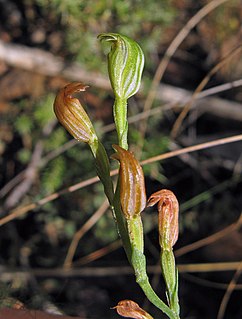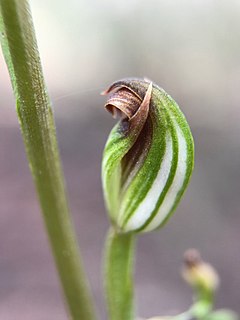
Pterostylis baptistii, commonly known as the king greenhood, is a species of orchid endemic to eastern Australia. Flowering plants have a rosette of stalked, dark green leaves and a single white flower with green and brown markings, and a wide gap between the petals and lateral sepals. It occurs mostly in New South Wales but is also found in coastal Queensland and north-eastern Victoria.

Pterostylis atrans, commonly known as the dark-tip greenhood or blunt-tongue greenhood, is a species of orchid endemic to south-eastern Australia. As with similar greenhoods, plants in flower differ from those that are not flowering. The non-flowering plants have a rosette of leaves flat on the ground, but the plants in flower have a single flower with leaves on the flowering spike. In this species, the flower is green and reddish brown with a protruding sinus and small club-like tips on the ends of the lateral sepals.

Pterostylis cucullata, commonly known as the leafy greenhood, is a plant in the orchid family Orchidaceae and is endemic to south-eastern Australia. It has a rosette of fleshy leaves at its base and a single white, green and reddish-brown flower.

Pterostylis monticola, commonly known as the large mountain greenhood, is a species of orchid endemic to south-eastern Australia. It has a rosette of fleshy leaves at the base of the plant and a single dark green and white flower. It grows in alpine and sub-alpine colonies.

Pterostylis parviflora, commonly known as the tiny greenhood, is a species of orchid endemic to south-eastern Australia. As with similar orchids, the flowering plants differ from those which are not flowering. The non-flowering plants have a rosette of leaves but the flowering plants lack a rosette at the base but have up to eight tiny green, white and brown flowers.

Pterostylis scabrida, commonly known as the rough greenhood, is a species of orchid endemic to Tasmania. It has a rosette of leaves at the base of the plant and a single green and white flower on a rough stem. It is widespread and common in wet forests and is one of the few species of Pterostylis to grow in rainforest.

Pterostylis aneba is a species of orchid endemic to south-eastern Australia. It is a recently described and poorly-known greenhood similar to Pterostylis alpina and P. monticola. It has a rosette of fleshy leaves at the base of the plant and a single green and white flower. It grows in alpine and sub-alpine habitats.

Pterostylis rubescens, commonly known as the blushing tiny greenhood, is a species of orchid endemic to south-eastern Australia. As with similar orchids, the flowering plants differ from those which are not flowering. The non-flowering plants have a rosette of leaves but the flowering plants lack a rosette at the base and have up to eighteen tiny green, white and brownish flowers.
Pterostylis anatona, commonly known as the Eungella greenhood, is a species of orchid endemic to Queensland. It has a rosette of wrinkled leaves at the base of the plant and a single light green and white flower, reddish towards its tip. It grows in higher areas between Eungella and the Blackdown Tableland National Park.
Pterostylis aphylla, commonly known as the leafless greenhood, is a species of orchid endemic to Tasmania. As with similar greenhoods, the flowering plants differ from those which are not flowering. The non-flowering plants have a rosette of leaves flat on the ground but in this species, the flowering plants have a single green and white flower with a brown tip and lack leaves apart from a few small scales.
Pterostylis aquilonia, commonly known as the northern cobra greenhood, is a species of orchid endemic to Queensland. As with similar orchids, the flowering plants differ from those which are not flowering. The non-flowering plants have a rosette of leaves but the flowering plants lack a rosette and have a single flower with leaves on the flowering spike. This greenhood has a relatively large green, white and reddish-brown self-pollinating flower.
Pterostylis ciliata, commonly known as the hairy rufous greenhood, tall rusthood or hairy rustyhood is a plant in the orchid family Orchidaceae and is endemic to the south-west of Western Australia. It has a relatively large rosette of leaves at its base and up to eight or more green and brown flowers which lean forward and have a small, fleshy, insect-like labellum covered with hairs.
Pterostylis crassichila, commonly known as the plump northern greenhood, is a species of orchid endemic to Queensland. It has a rosette of leaves at the base of the plant and a single white flower with green lines, reddish towards its tip. It grows in higher areas of north Queensland.
Pterostylis dubia, commonly known as the blue-tongued greenhood, is a plant in the orchid family Orchidaceae and is endemic to Tasmania. It has a rosette of fleshy leaves at its base and a dark green and white flower with narrow petals and a dark blue-green labellum.
Pterostylis erythroconcha, commonly known as the red shell orchid, is a species of orchid endemic to South Australia. As with similar orchids, the flowering plants differ from those which are not flowering. The non-flowering plants have a rosette of leaves but the flowering plants have a single flower with leaves on the flowering spike. This greenhood has a white and green flower with reddish brown markings and a long, fleshy, curved labellum.
Pterostylis procera, commonly known as the short-lipped greenhood, is a species of orchid endemic to Queensland. It has a rosette of leaves and when flowering a single translucent white flower with green and reddish markings and a labellum which does not protrude through the lateral sepals.
Pterostylis subtilis, commonly known as the thin mountain greenhood, is a species of orchid endemic to New South Wales. It has a rosette of leaves and when flowering a single translucent white flower with dark green lines, a narrow, deeply notched sinus between the lateral sepals and a curved, protruding labellum.
Pterostylis timorensis is a plant in the orchid family Orchidaceae and is endemic to East Timor. Both flowering and non-flowering plants have a rosette of light green, fleshy leaves. Flowering plants have a single green, white and reddish-brown flower and two or three stem leaves.
Pterostylis uliginosa, commonly known as the marsh greenhood, is a species of orchid endemic to south-eastern Australia. As with similar orchids, the flowering plants differ from those which are not flowering. The non-flowering plants have a rosette of leaves but the flowering plants lack a rosette at the base but have up to three rosettes on lateral growths and up to seven small green and white flowers. This species only grows in wet places, usually where there is free water. There are usually only two or three flowers per plant, and only one or two are open at a time.
Pterostylis oreophila, commonly known as the Kiandra greenhood or blue-tongued greenhood is a species of orchid endemic to south-eastern Australia. Flowering and non-flowering plants have three to five dark green, fleshy leaves and flowering plants have a single green and white, sickle-shaped flower with a deeply notched, bulging sinus between the lateral sepals.















